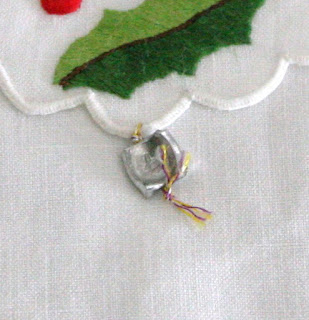The industry was vibrant throughout the early 1900’s but
suffered a decline in the years of the First World War (1914-18). The quality
declined and the product was not of the previous high standard. There was a
resurgence of interest in the post war era as the demand for high quality
products increased. It was then that many of the companies were founded
Patricio & Gouveia (1925); Imperial de Bordados (1926); J.A. Teixeira
(1937). Many of these linens were exported to the US, a huge market with the
peak period being the 1950’s. Several companies were then American owned
(Jabara; Marghab Linens and Imperial). Much of the trade was lost in the 1970’s
due to the opening of the market to Chinese imports.
Linens embroidered in Madeira are still held in high regard
as the quality of workmanship remains high. They are still exported and those
of the highest standard are given the Gremio, a silver metal disc attached by a
thread to the work.
One of the names that has become the benchmark for the
quality of Madeira linens is Marghab.
Marghab Linens, Ltd. was founded in the 1930’s by Emile and Vera (nee
Way) Marghab. Vera, an American, was born in 1900 in Wesley, Iowa and grew up
in Watertown, South Dakota. Vera had hoped to follow a career in music and
studied in New York where she met Emile Marghab, a British subject from Cyprus
and an extended courtship began that lead to their marriage in 1931. They
divided their time between New York and Madeira, where Emile had started an
embroidery firm. In 1933 Vera joined him as a business partner and the business
became Emile Marghab and Company, incorporating in New York the following year
as Emile Marghab, Inc.
Marghab pattern known as 'Knight'
The reason the Marghab linens became the benchmark for the
industry was the fact that Vera oversaw all aspects of the production and her
desire for ‘perfection-nothing less’ made sure everything was of the highest
quality. Vera selected the embroideresses; chose the fabrics and threads and
also designed many of the pieces. She also selected the shops where the products
sold-Neiman Marcus; Lord & Taylor and Marshall Fields, to name a few.
Marghab pattern known as 'Flower Lady'
The highest quality Irish linen; a form of organdy, called Margandie was made in Switzerland especially
for Marghab (it was harder wearing than the usual organdy) and threads from
France and England were used to produce the Marghab linens. The work was done
by the embroideresses in their homes and per Vera’s instructions, they were paid
for each stitch they made. In a single placemat you could count over 70,000
stitches! Everything was checked and nothing but perfection allowed to bear the
Marghab name. The Marghab linens had a paper tag pinned to them with the
company logo, a Portuguese sailing ship, along with the pattern number and size
of the item.
Detailed buttonhole edging on Marghab napkins
Emile died in 1947 but Vera continued to supervise the
business for a further 30 years until its disestablishment in 1980 due to
political changes in Portugal. Vera returned to live in her childhood home in
Watertown, South Dakota and remained active in business affairs and charity
work. She donated her collection of Marghab linens to the South Dakota Art
Museum in 1970 which, with subsequent donations from Vera and her estate (she
died in 1995), now consists of over 300 patterns and is the most comprehensive
collection of Marghab linens in the world.
Reverse side of Marghab Knight
Want to know if you have any pieces of Marghab linen? You
can see many of the patterns by doing an Internet search. You can also make an
appointment and take your piece to the South Dakota Art Museum for museum staff
to verify the authenticity.






No comments:
Post a Comment